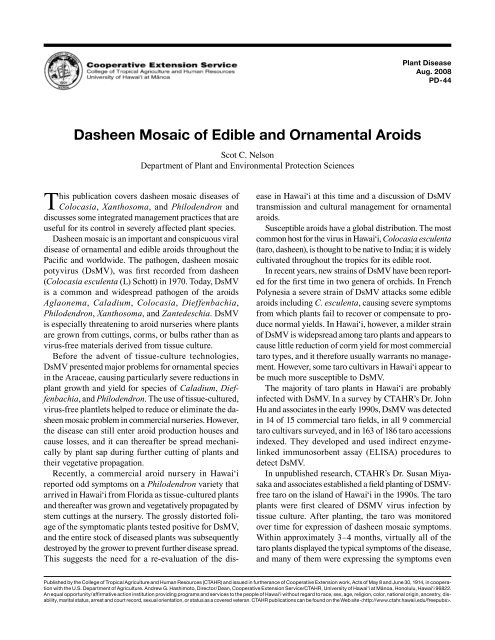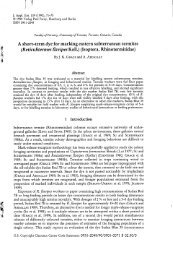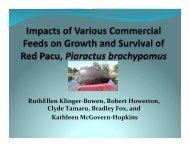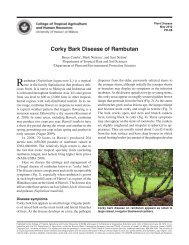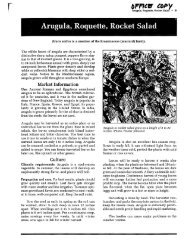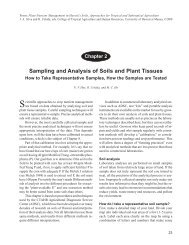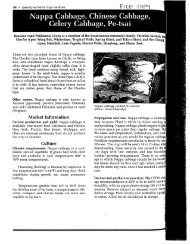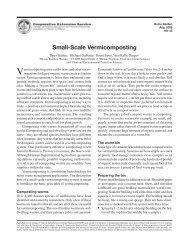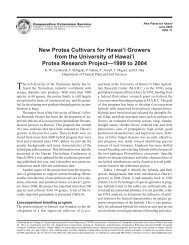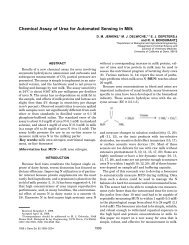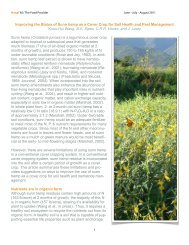Dasheen Mosaic of Edible and Ornamental Aroids - College of ...
Dasheen Mosaic of Edible and Ornamental Aroids - College of ...
Dasheen Mosaic of Edible and Ornamental Aroids - College of ...
Create successful ePaper yourself
Turn your PDF publications into a flip-book with our unique Google optimized e-Paper software.
<strong>Dasheen</strong> <strong>Mosaic</strong> <strong>of</strong> <strong>Edible</strong> <strong>and</strong> <strong>Ornamental</strong> <strong>Aroids</strong><br />
Scot C. Nelson<br />
Department <strong>of</strong> Plant <strong>and</strong> Environmental Protection Sciences<br />
This publication covers dasheen mosaic diseases <strong>of</strong><br />
Colocasia, Xanthosoma, <strong>and</strong> Philodendron <strong>and</strong><br />
discusses some integrated management practices that are<br />
useful for its control in severely affected plant species.<br />
<strong>Dasheen</strong> mosaic is an important <strong>and</strong> conspicuous viral<br />
disease <strong>of</strong> ornamental <strong>and</strong> edible aroids throughout the<br />
Pacific <strong>and</strong> worldwide. The pathogen, dasheen mosaic<br />
potyvirus (DsMV), was first recorded from dasheen<br />
(Colocasia esculenta (L) Schott) in 1970. Today, DsMV<br />
is a common <strong>and</strong> widespread pathogen <strong>of</strong> the aroids<br />
Aglaonema, Caladium, Colocasia, Dieffenbachia,<br />
Philodendron, Xanthosoma, <strong>and</strong> Zantedeschia. DsMV<br />
is especially threatening to aroid nurseries where plants<br />
are grown from cuttings, corms, or bulbs rather than as<br />
virus-free materials derived from tissue culture.<br />
Before the advent <strong>of</strong> tissue-culture technologies,<br />
DsMV presented major problems for ornamental species<br />
in the Araceae, causing particularly severe reductions in<br />
plant growth <strong>and</strong> yield for species <strong>of</strong> Caladium, Dieffenbachia,<br />
<strong>and</strong> Philodendron. The use <strong>of</strong> tissue-cultured,<br />
virus-free plantlets helped to reduce or eliminate the dasheen<br />
mosaic problem in commercial nurseries. However,<br />
the disease can still enter aroid production houses <strong>and</strong><br />
cause losses, <strong>and</strong> it can thereafter be spread mechanically<br />
by plant sap during further cutting <strong>of</strong> plants <strong>and</strong><br />
their vegetative propagation.<br />
Recently, a commercial aroid nursery in Hawai‘i<br />
reported odd symptoms on a Philodendron variety that<br />
arrived in Hawai‘i from Florida as tissue-cultured plants<br />
<strong>and</strong> thereafter was grown <strong>and</strong> vegetatively propagated by<br />
stem cuttings at the nursery. The grossly distorted foliage<br />
<strong>of</strong> the symptomatic plants tested positive for DsMV,<br />
<strong>and</strong> the entire stock <strong>of</strong> diseased plants was subsequently<br />
destroyed by the grower to prevent further disease spread.<br />
This suggests the need for a re-evaluation <strong>of</strong> the dis-<br />
Plant Disease<br />
Aug. 2008<br />
PD-44<br />
ease in Hawai‘i at this time <strong>and</strong> a discussion <strong>of</strong> DsMV<br />
transmission <strong>and</strong> cultural management for ornamental<br />
aroids.<br />
Susceptible aroids have a global distribution. The most<br />
common host for the virus in Hawai‘i, Colocasia esculenta<br />
(taro, dasheen), is thought to be native to India; it is widely<br />
cultivated throughout the tropics for its edible root.<br />
In recent years, new strains <strong>of</strong> DsMV have been reported<br />
for the first time in two genera <strong>of</strong> orchids. In French<br />
Polynesia a severe strain <strong>of</strong> DsMV attacks some edible<br />
aroids including C. esculenta, causing severe symptoms<br />
from which plants fail to recover or compensate to produce<br />
normal yields. In Hawai‘i, however, a milder strain<br />
<strong>of</strong> DsMV is widepsread among taro plants <strong>and</strong> appears to<br />
cause little reduction <strong>of</strong> corm yield for most commercial<br />
taro types, <strong>and</strong> it therefore usually warrants no management.<br />
However, some taro cultivars in Hawai‘i appear to<br />
be much more susceptible to DsMV.<br />
The majority <strong>of</strong> taro plants in Hawai‘i are probably<br />
infected with DsMV. In a survey by CTAHR’s Dr. John<br />
Hu <strong>and</strong> associates in the early 1990s, DsMV was detected<br />
in 14 <strong>of</strong> 15 commercial taro fields, in all 9 commercial<br />
taro cultivars surveyed, <strong>and</strong> in 163 <strong>of</strong> 186 taro accessions<br />
indexed. They developed <strong>and</strong> used indirect enzymelinked<br />
immunosorbent assay (ELISA) procedures to<br />
detect DsMV.<br />
In unpublished research, CTAHR’s Dr. Susan Miyasaka<br />
<strong>and</strong> associates established a field planting <strong>of</strong> DSMVfree<br />
taro on the isl<strong>and</strong> <strong>of</strong> Hawai‘i in the 1990s. The taro<br />
plants were first cleared <strong>of</strong> DSMV virus infection by<br />
tissue culture. After planting, the taro was monitored<br />
over time for expression <strong>of</strong> dasheen mosaic symptoms.<br />
Within approximately 3–4 months, virtually all <strong>of</strong> the<br />
taro plants displayed the typical symptoms <strong>of</strong> the disease,<br />
<strong>and</strong> many <strong>of</strong> them were expressing the symptoms even<br />
Published by the <strong>College</strong> <strong>of</strong> Tropical Agriculture <strong>and</strong> Human Resources (CTAHR) <strong>and</strong> issued in furtherance <strong>of</strong> Cooperative Extension work, Acts <strong>of</strong> May 8 <strong>and</strong> June 30, 1914, in cooperation<br />
with the U.S. Department <strong>of</strong> Agriculture. Andrew G. Hashimoto, Director/Dean, Cooperative Extension Service/CTAHR, University <strong>of</strong> Hawai‘i at Mänoa, Honolulu, Hawai‘i 96822.<br />
An equal opportunity/affirmative action institution providing programs <strong>and</strong> services to the people <strong>of</strong> Hawai‘i without regard to race, sex, age, religion, color, national origin, ancestry, disability,<br />
marital status, arrest <strong>and</strong> court record, sexual orientation, or status as a covered veteran. CTAHR publications can be found on the Web site .
UH–CTAHR <strong>Dasheen</strong> <strong>Mosaic</strong> <strong>of</strong> <strong>Edible</strong> <strong>and</strong> <strong>Ornamental</strong> <strong>Aroids</strong> PD-44 — Aug. 2008<br />
more severely than expected. The presence <strong>of</strong> a DsMV<br />
vector, the green peach aphid (Myzus persicae), was<br />
confirmed in the taro field (Susan Miyaska, personal<br />
communication).<br />
Some speculate or believe that certain Hawaiian taro<br />
cultivars are, or were, much more susceptible to dasheen<br />
mosaic, <strong>and</strong> that what remains <strong>of</strong> the original population<br />
<strong>of</strong> Hawaiian taro varieties is perhaps more tolerant <strong>of</strong><br />
the disease <strong>and</strong> those varieties that have been become<br />
extinct or have been lost from taro collections may have<br />
been more intolerant <strong>of</strong> DsMV infections.<br />
It is commonly reported that DsMV does not cause<br />
substantial yield loss to taro, <strong>and</strong> that is still a prevailing<br />
opinion for this taro disease in Hawaii. However,<br />
depending on the host-virus strain combination <strong>and</strong> the<br />
location, DsMV can severely impact yields <strong>of</strong> the edible<br />
aroids Colocasia <strong>and</strong> Xanthosoma in the Pacific. Symptoms<br />
on the more susceptible varieties include chlorotic<br />
feathering patterns on leaves <strong>and</strong> severe leaf curling <strong>and</strong><br />
malformations.<br />
Hosts<br />
Most <strong>of</strong> the known hosts <strong>of</strong> DsMV are among edible<br />
<strong>and</strong> ornamental species <strong>of</strong> the Araceae (aroids). Worldwide,<br />
DsMV infects least 16 genera in this family <strong>and</strong> is<br />
widespread among the edible Colocasia, Xanthosoma,<br />
<strong>and</strong> Cyrtosperma species <strong>and</strong> among the inedible ornamental<br />
genera Aglaonema, Caladium, Dieffenbachia,<br />
Philodendron, <strong>and</strong> Zantedeschia.<br />
<strong>Aroids</strong> are plants <strong>of</strong> the family Araceae; they have<br />
small flowers massed on a spadix surrounded by a large<br />
spathe. <strong>Aroids</strong> are widespread globally <strong>and</strong> very abundant<br />
in the tropics. The inedible aroids are important<br />
ornamental home <strong>and</strong> garden plants. The edible aroids<br />
are tremendously important to diets <strong>of</strong> indigenous tropical<br />
societies as staple starch-food crops that are capable<br />
<strong>of</strong> withst<strong>and</strong>ing the damaging effects <strong>of</strong> tidal waves <strong>and</strong><br />
hurricanes. Taro, perhaps the most widely grown <strong>of</strong> the<br />
edible aroids, is a perennial herb consisting <strong>of</strong> a cluster<br />
<strong>of</strong> smooth, heart-shaped leaves, rising a foot or higher<br />
from underground tubers. In temperate areas it is grown<br />
as an ornamental plant for its large, glossy leaves.<br />
In the Orchidaceae, Vanilla tahitensis is a host <strong>of</strong><br />
unique strains <strong>of</strong> DsMV in French Polynesia <strong>and</strong> the<br />
Cook Isl<strong>and</strong>s; a terrestrial orchid, Spiranthes cernua,<br />
hosts a strain <strong>of</strong> DsMV in the continental United States.<br />
Hosts <strong>of</strong> DsMV may be grouped on the basis <strong>of</strong> their<br />
symptom expression (Table 1).<br />
2<br />
At top, leaf malformation <strong>and</strong> chlorotic feathering along<br />
leaf veins are characteristic symptoms <strong>of</strong> dasheen<br />
mosaic disease <strong>of</strong> taro (Colocasia esculenta). Above,<br />
close-up <strong>of</strong> the typical feathering symptom on a taro<br />
leaf. (Photos: S. Nelson)
UH–CTAHR <strong>Dasheen</strong> <strong>Mosaic</strong> <strong>of</strong> <strong>Edible</strong> <strong>and</strong> <strong>Ornamental</strong> <strong>Aroids</strong> PD-44 — Aug. 2008<br />
Symptoms <strong>of</strong> dasheen mosaic on taro (Colocasia esculenta): pale whitish to yellow to yellow-green patches on the<br />
leaves, characteristically as featherlike patterns along the veins, especially near leaf margins, <strong>and</strong> leaf deformities.<br />
Two or three leaves on a plant may show symptoms, but thereafter normal leaves are produced.<br />
(Photo at left, W. Nishijima, at right, S. Nelson)<br />
Feathering symptoms on the underside <strong>of</strong> a taro leaf (left) may be associated with reddening or necrosis <strong>of</strong> small<br />
leaf veins. Leaf malformation <strong>of</strong> taro caused by DsMV infection (right) may consist <strong>of</strong> wrinkling <strong>and</strong> puckering <strong>of</strong> leaf<br />
surfaces <strong>and</strong> leaf margins (Photos: S. Nelson)<br />
3
UH–CTAHR <strong>Dasheen</strong> <strong>Mosaic</strong> <strong>of</strong> <strong>Edible</strong> <strong>and</strong> <strong>Ornamental</strong> <strong>Aroids</strong> PD-44 — Aug. 2008<br />
Conspicuous necrotic <strong>and</strong> chlorotic feathering along leaf veins <strong>of</strong> a dasheen variety (Photo: S. Nelson)<br />
Symptom expression, infection, <strong>and</strong><br />
disease effects<br />
There may be some overlapping for symptom expression<br />
among plant genera; variability in symptom expression<br />
may depend on the host, the particular strain <strong>of</strong> DsMV,<br />
<strong>and</strong> the environment. For example, when severely diseased,<br />
Philodendron may exhibit vein clearing that<br />
resembles chlorotic feathering. Also, symptoms may be<br />
intermittent or vary seasonally. For taro, two or three<br />
leaves may show symptoms <strong>and</strong> then apparently healthy<br />
leaves are produced, or leaves may alternate between<br />
asymptomatic <strong>and</strong> symptomatic on the same plant.<br />
The pathogen infects leaves, stems, <strong>and</strong> petioles. The<br />
disease results in reduced photosynthesis, reduced corm<br />
size or yield, reduction in leaf number or size, deformed<br />
leaves, <strong>and</strong> stunted plants.<br />
4<br />
Disease cycle for dasheen mosaic<br />
Dispersal: DsMV is dispersed by several species <strong>of</strong><br />
aphids, by the movement <strong>of</strong> infected plants; as infected<br />
plant sap on pruning tools.<br />
Inoculation: DsMV arrives at the site <strong>of</strong> infection (a<br />
wounded plant cell) in an aphid’s mouthparts or on<br />
an infested cutting tool.<br />
Infection: DsMV enters a wounded plant cell either by<br />
aphid injection or on an infested tool.<br />
Disease development: Virus particles multiply within<br />
plant host cells, eventually resulting in symptom<br />
development. Virus particles move between adjacent<br />
cells via plasmodesmata <strong>and</strong> long-distance within a<br />
plant via the vascular tissues.<br />
Pathogen reproduction: The virus particles replicate by<br />
usurping the plant cell’s DNA <strong>and</strong> protein-synthesizing<br />
capacities.
UH–CTAHR <strong>Dasheen</strong> <strong>Mosaic</strong> <strong>of</strong> <strong>Edible</strong> <strong>and</strong> <strong>Ornamental</strong> <strong>Aroids</strong> PD-44 — Aug. 2008<br />
Table 1. General types <strong>of</strong> disease symptoms caused by DsMV <strong>and</strong> corresponding plant genera that express the<br />
symptoms.<br />
Symptoms Susceptible genera<br />
Systemic mosaic* Aglaonema, Alocasia, Amorphophallus, Arisaema, Caladium*,<br />
Cyrtosperma<br />
Systemic mosaic, leaf malformation, epinasty, Cryptocoryne, Dieffenbachia, Philodendron, Richardia, Zantedeschia<br />
vein clearing, systemic <strong>and</strong> local necrosis<br />
Systemic mosaic, leaf malformation, Colocasia, Xanthosoma<br />
chlorotic feathering along leaf veins<br />
Leaf mosaic <strong>and</strong> malformation Vanilla tahitensis<br />
Systemic mosaic, chlorotic blotching Spiranthes cernua<br />
*some cultivars <strong>of</strong> Caladium hortulanum may show feathering along leaf veins.<br />
<strong>Mosaic</strong> <strong>and</strong> veinal feathering symptom on both sides <strong>of</strong> a leaf <strong>of</strong> a Hawaiian taro variety (Photo: S. Nelson)
UH–CTAHR <strong>Dasheen</strong> <strong>Mosaic</strong> <strong>of</strong> <strong>Edible</strong> <strong>and</strong> <strong>Ornamental</strong> <strong>Aroids</strong> PD-44 — Aug. 2008<br />
DsMV on Xanthosoma sagittifolium. Left: white feathering symptoms along the leaf veins <strong>of</strong> X. sagittifolium in Yap.<br />
The feathering symptom associated with DsMV is typical <strong>of</strong> Colocasia <strong>and</strong> Xanthosoma species. The the newly<br />
emerging leaf (mostly obscured here) is grossly distorted. Right: leaf distortion (puckering) associated with DsMV<br />
<strong>and</strong> the white feathery symptom on X. sagittifolium in Yap. (Photos: Craig Elevitch)<br />
Pathogen survival: DsMV survives as viable virus particles<br />
within living plant tissues, or for short periods<br />
<strong>of</strong> time in association with the mouthparts <strong>of</strong> aphid<br />
species or as infested sap on tools. DsMV is unable to<br />
survive in dead plant tissues or in dead aphids.<br />
DsMV is transmissible by three methods<br />
Vectors: DSMV is transmitted by several species <strong>of</strong><br />
aphids, including the green peach aphid (Myzus persicae),<br />
the cowpea aphid (Aphis craccivora), <strong>and</strong> the<br />
melon aphid (Aphis gossypii). DsMV is not transmitted<br />
by the banana aphid (Pentalonia nigronervosa) or<br />
by the bird cherry-oat aphid (Rhopalosiphum padi).<br />
The virus is transmitted in a non-persistent manner.<br />
6<br />
Vegetatively: by suckers, corms, or infected cuttings used<br />
for propagation.<br />
Mechanically: by plant sap on knives or shears (yet<br />
DsMV is not transmitted by incidental contact or<br />
natural rubbing <strong>of</strong> leaves between plants).<br />
Note: DsMV is not transmitted by seed or by pollen.<br />
Integrated management <strong>of</strong> dasheen mosaic<br />
Disease management tactics depend upon the crop. For<br />
taro in Hawai‘i, management <strong>of</strong> DSMV is generally not<br />
warranted on most varieties because the disease apparently<br />
has a negligible effect on corm yields. However, symptom<br />
expression may be relatively severe on some heirloom<br />
Hawaiian taro varieties in some environments.
UH–CTAHR <strong>Dasheen</strong> <strong>Mosaic</strong> <strong>of</strong> <strong>Edible</strong> <strong>and</strong> <strong>Ornamental</strong> <strong>Aroids</strong> PD-44 — Aug. 2008<br />
Symptoms <strong>of</strong> dasheen mosaic on Philodendron: Leaves<br />
<strong>of</strong> Philodendron x cv. 'Hope' as a host <strong>of</strong> DsMV in Hawaii.<br />
The test kit shows a positive reaction to potyviruses.<br />
The virus was confirmed by ELISA <strong>and</strong> PCR. Symptoms<br />
on this Philodendron include mosaic, green isl<strong>and</strong>s,<br />
deformity, rugosity, epinasty, curling, yellowing <strong>and</strong><br />
vein clearing. The cultural practices used by the grower<br />
included vegetative propagation <strong>of</strong> this plant by cutting<br />
stems with knives or shears. This may have been the<br />
means for mechanical transmission <strong>of</strong> DsMV in this case.<br />
(Photo: Brian Bushe, UH-CTAHR)<br />
<strong>Dasheen</strong> mosaic can cause major economic losses<br />
for ornamental crops such as Philodendron; in this case<br />
management <strong>of</strong> the disease is highly recommended due<br />
to the damaging effects upon the plant foliage.<br />
IPM (integrated pest management) principles<br />
• Avoid introduction or transmission <strong>of</strong> the virus during<br />
vegetative propagation.<br />
• Prevent the introduction <strong>and</strong> spread <strong>of</strong> this disease on<br />
new hosts.<br />
• Control aphids <strong>and</strong> ants where aphid transmission <strong>of</strong><br />
DsMV is a problem.<br />
Close-up <strong>of</strong> adult melon aphids (Aphis gossypii, adult<br />
apterous females, highly magnified) on a kava (Piper<br />
methysticum) leaf. Colonies <strong>of</strong> aphids <strong>and</strong> ants are<br />
common on leaves <strong>of</strong> taro in Hawai‘i. Not all aphids<br />
found on taro can transmit the virus; for example, banana<br />
aphids. (Photo: S. Nelson)<br />
Some variegated aroids do not carry DsMV: Variegated<br />
Pothos (Epipremnum sp.), showing symptoms <strong>of</strong> leaf<br />
mosaic <strong>and</strong> perhaps yellow veins, <strong>and</strong> with leaf deformity<br />
<strong>and</strong> rugosity due to feeding injury by aroid thrips. These<br />
symptoms should not be confused with DsMV on other<br />
aroid hosts. The mosaic symptom is due to genetic<br />
variegation, not to disease. (Photo: S. Nelson)
UH–CTAHR <strong>Dasheen</strong> <strong>Mosaic</strong> <strong>of</strong> <strong>Edible</strong> <strong>and</strong> <strong>Ornamental</strong> <strong>Aroids</strong> PD-44 — Aug. 2008<br />
IPM tactics<br />
• Take cuttings or vegetative sprouts from virus-free<br />
plants only.<br />
• Prevent mechanical transmission <strong>of</strong> the virus on knives<br />
<strong>and</strong> shears (dip knives in sterilizing solution between<br />
cuts).<br />
• Use certified plants from tissue culture.<br />
• Plant quarantine: intercept diseased plants at point <strong>of</strong><br />
entry.<br />
• Nurseries should inspect plants upon arrival <strong>and</strong> before<br />
shipping to prevent the spread <strong>of</strong> plant diseases<br />
in Hawai‘i.<br />
• Avoid intercropping taro with other susceptible aroids.<br />
• Avoid using the same knives or blades that are used to<br />
harvest taro leaves for vegetative propagation <strong>of</strong> other<br />
susceptible aroids.<br />
• Avoid growing taro in nurseries alongside other susceptible<br />
aroids.<br />
• Propagate from seed (DsMV is not seed-transmissible).<br />
• Culture plants from shoot tips.<br />
• Control the aphid vectors where the disease is causing<br />
losses.<br />
To detect the disease, visually inspect all leaves <strong>of</strong> plants<br />
for white feathering symptoms (Colocasia, Xanthosoma,<br />
<strong>and</strong> some cultivars <strong>of</strong> Caladium hortulanum such as<br />
‘C<strong>and</strong>idum,’ ‘C<strong>and</strong>idum Junior’, <strong>and</strong> ‘White Christmas’)<br />
or mosaics <strong>and</strong> leaf deformation (Philodendron, Dieffenbachiae,<br />
Spathiphyllum, <strong>and</strong> Zantedeschia, for example).<br />
<strong>Ornamental</strong> greenhouse-grown aroids may express symptoms<br />
intermittently or even be asymptomatic.<br />
When a symptomatic aroid is submitted to the CTAHR<br />
Agricultural Diagnostic Service Center for virus detection,<br />
the test consists <strong>of</strong> one or more <strong>of</strong> the following:<br />
• ELISA (enzyme-linked immunosorbent assay) for<br />
potyvirus<br />
• PCR (polymerase chain reaction) or DsMV-specific<br />
ELISA test.<br />
8<br />
Diagnostically susceptible host species<br />
<strong>and</strong> symptoms<br />
Philodendron selloum: systemic mosaic, vein clearing,<br />
malformation.<br />
Caladium hortulanum, Colocasia spp., Xanthosoma<br />
spp.: systemic mosaic.<br />
Dieffenbachia spp.: systemic mosaic, epinasty, systemic<br />
<strong>and</strong> local necrosis.<br />
Philodendron verrucosum: local necrosis; not systemic.<br />
Zantedeschia spp.: systemic mosaic, malformation.<br />
Notes<br />
Taro is also susceptible to at least two other plant-pathogenic<br />
viruses not yet in Hawai‘i, Colocasia bobone<br />
disease rhabdovirus (cause <strong>of</strong> bobone disease) <strong>and</strong> dasheen<br />
bacilliform badnavirus (cause <strong>of</strong> alomae disease).<br />
The symptoms are somewhat similar in appearance to<br />
dasheen mosaic, yet more severe mosaic, leaf malformation<br />
<strong>and</strong> curling occurs with much more severe effects<br />
upon plant growth.<br />
References<br />
Elliot, M.S., F.W. Zettler, <strong>and</strong> L.G. Brown. <strong>Dasheen</strong><br />
mosaic potyvirus <strong>of</strong> edible <strong>and</strong> ornamental aroids.<br />
University <strong>of</strong> Florida, Plant Pathology Circular no.<br />
384.<br />
Plant Viruses Online. http://image.fs.uidaho.edu/vide/<br />
descr289.htm.<br />
Farreyrol, K., M.N. Pearson, M. Grisoni, D. Cohen, <strong>and</strong><br />
D. Beck. 2006. Vanilla mosaic virus isolates from<br />
French Polynesia <strong>and</strong> the Cook Isl<strong>and</strong>s are <strong>Dasheen</strong><br />
mosaic virus strains that exclusively infect vanilla.<br />
Archives <strong>of</strong> Virology 151:905–919.<br />
Jordan, R., M.A. Guaranga, G. Kinard, <strong>and</strong> S. Lynn.<br />
Detection <strong>and</strong> first report <strong>of</strong> dasheen mosaic virus<br />
<strong>and</strong> a second potyvirus infecting the terrestrial orchid<br />
Spiranthes cernua. Acta Horticulturae (ISHS)<br />
568:253–260.<br />
Hu, J.S., M. Wang, R. Reolanei, <strong>and</strong> S. Meleisea. 1994.<br />
Detection <strong>of</strong> dasheen mosaic virus from taro plants in<br />
the field <strong>and</strong> in tissue culture. Plant Disease 78:754.<br />
Hu, J.S., S. Meleisea, M. Wang, M.A. Shaarawy, <strong>and</strong> F.W.<br />
Zettler. 1995. <strong>Dasheen</strong> mosaic potyvirus in Hawaiian<br />
taro. Austral. Plant Pathol. 24:112–117.<br />
Kohler, F., F. Pellegrin, G. Jackson, <strong>and</strong> E. McKenzie.<br />
1997. Disease <strong>of</strong> cultivated crops in Pacific isl<strong>and</strong><br />
countries. South Pacific Commission, Noumea, New
UH–CTAHR <strong>Dasheen</strong> <strong>Mosaic</strong> <strong>of</strong> <strong>Edible</strong> <strong>and</strong> <strong>Ornamental</strong> <strong>Aroids</strong> PD-44 — Aug. 2008<br />
Caledonia.<br />
Liu, L.J.Y., E. Rosa-Marquez, M. Licha, <strong>and</strong> M.L. Biascoechea.<br />
1988. Tanier (Xanthosoma spp.) propagation<br />
in vitro. Journal <strong>of</strong> Agriculture <strong>of</strong> the University <strong>of</strong><br />
Puerto Rico. 72:413-426.<br />
Neal, M.C. 1965. In gardens <strong>of</strong> Hawaii. Bishop Museum<br />
Press, Honolulu.<br />
Wagner, W.L., D.R. Herbst, <strong>and</strong> S.H. Sohnmer. 1990.<br />
Manual <strong>of</strong> the flowering plants <strong>of</strong> Hawaii. Bishop<br />
Museum Press, Honolulu.<br />
Zettler, F.W., <strong>and</strong> R.D. Hartman. 1987. <strong>Dasheen</strong> mosaic<br />
potyvirus as a pathogen <strong>of</strong> cultivated aroids <strong>and</strong><br />
control <strong>of</strong> the virus by tissue culture. Plant Disease<br />
71:958–963.<br />
Acknowledgments<br />
John Hu, UH-CTAHR, for information <strong>and</strong> a review <strong>of</strong><br />
the manuscript; Wayne Nishijima, UH-CTAHR, for providing<br />
a photograph; Craig Elevitch, www.agr<strong>of</strong>orestry.<br />
net, for providing two photographs; Brian Bushe, UH-<br />
CTAHR, for providing information <strong>and</strong> a photograph<br />
<strong>and</strong> for diagnostic work; Mike Shintaku, UH-Hilo, for<br />
providing diagnostic work <strong>and</strong> information; Susan Miyasaka,<br />
UH-CTAHR, for information <strong>and</strong> discussion; Fred<br />
Brooks, UH-CTAHR, for review <strong>of</strong> the manuscript.<br />
9


